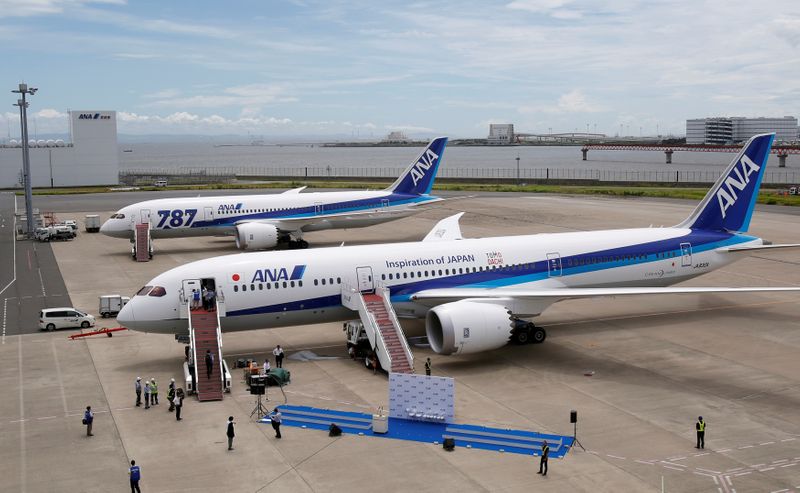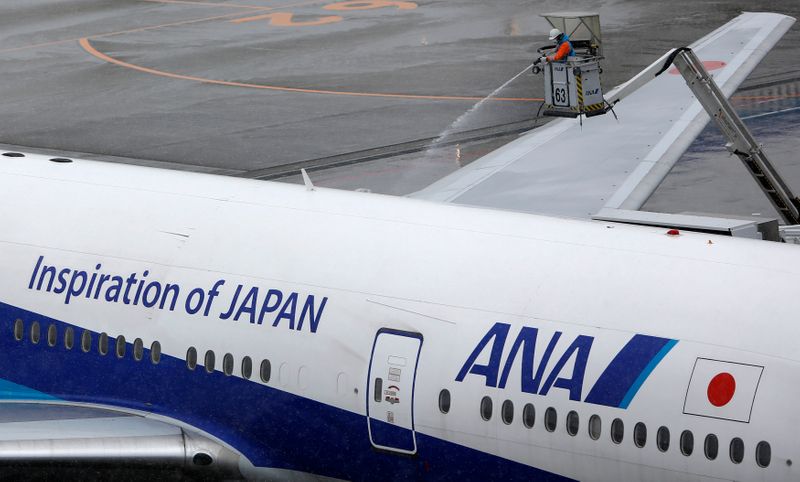TOKYO (Reuters) – Japan’s biggest airline, ANA, has turned to billions of dollars in loans and a government tourism campaign to weather the slump in air travel and could take advantage of accounting rules to avoid aircraft writedowns.
Like other carriers, ANA has been burning through cash to maintain jets that are either grounded or flying with too few passengers during the coronavirus pandemic, pushing it to an operating loss of 159 billion yen ($1.51 billion) for the April-June quarter.
Sources told Reuters on Wednesday that ANA Holdings Inc <9202.T> has secured $3.8 billion in subordinated loans from state-backed and private lenders.
That means it will have raised $13.29 billion of debt to cope with the coronavirus fallout, says Yasuhito Tsuchiya, a senior analyst at Mitsubishi UFJ Morgan Stanley Securities.
“It looks like they will have enough to survive,” said Tsuchiya, who forecasts the carrier is on course for a record operating loss of around 400 billion yen for the full year ending March 31.
The airline is slashing personnel costs through redundancies and pay cuts. Along with rival Japan Airlines Co Ltd (JAL) <9201.T>, it is also getting government help including a waiver on airport landing fees, as Tokyo sees the carriers as crucial to keeping Japan, a 3,000-kilometre archipelago stretching along the edge of East Asia, connected.
ANA, which reported a negative cashflow from operations of 135 billion yen for April-June, has said it doesn’t expect its international air travel to fully recover until 2024.
It has more than 300 planes, including Airbus A380 super jumbos and twin-aisle jets such as the Boeing 787 Dreamliners, and owns two thirds of its fleet while leasing the rest.
At the end of June ANA said its aircraft were worth 1.14 trillion yen ($10.83 billion), almost unchanged from the previous year, but analysts say that is probably not a true reflection of their current market value.
Keeping planes that are grounded or underutilised could prove expensive because of parking and maintenance fees, which last business year cost ANA 177 billion yen.
Writedowns on some of them could add to a bottom line loss, but would allow the carrier to reduce depreciation charges in a boost to future earnings.
Analysts, however, say ANA could instead take advantage of international aviation accounting rules that don’t force it to revalue planes to reflect market prices, allowing it to avoid painful writedowns and the need to raise equity.
“ANA has too many big aircraft, The loss of value calculated on the current market, would be enormous, so there is no way they can sell them,” said Hajime Tozaki, an economics professor at J.F. Oberlin University in Tokyo and a former JAL employee.
Aviation consultant IBA this month estimated the value of aircraft owned by airlines had dropped $60 billion, or 40% lower than what they would be if supply and demand were balanced.
“Finding buyers right now at any price is rather difficult, except lessors who are looking to find bargains at low prices,” said Teal Group aerospace analyst Richard Aboulafia.
HOME ADVANTAGE
Tsuchiya said ANA and JAL have the advantage of a large domestic market with few competitors to help temper losses that other big Asian airlines like Singapore Airlines Ltd <SIAL.SI> and Cathay Pacific Airways Ltd <0293.HK> lack.
ANA was the world’s ninth largest airline this summer based on seat capacity, up from 15th a year ago, according to data firm OAG, due to the relative strength of that home market.
Before the pandemic, ANA generated over half its revenue from domestic flights and demand has rebounded helped by the government’s “Go To Travel” campaign launched in July to revive domestic tourism, which offers to pay up to half the cost of trips.
Domestic bookings in October are around 50% of last year, the ANA spokeswoman said, while the carrier has said international traffic is at 5% of levels seen in 2019.
ANA, which must repay around 200 billion yen in debt in the coming year, is due to release results for the July-September quarter on Oct. 27.
The Japanese government announced further help for carriers on Friday, saying it would reduce airport landing fees by a record 45% on all domestic flights for seven months through February.
“The government needs both JAL and ANA as national flag carriers,” said Tozaki.
(Reporting by Tim Kelly; additional reporting by Ami Miyazaki and Takashi Umekawa in Tokyo; Editing by Jamie Freed and Susan Fenton)


























